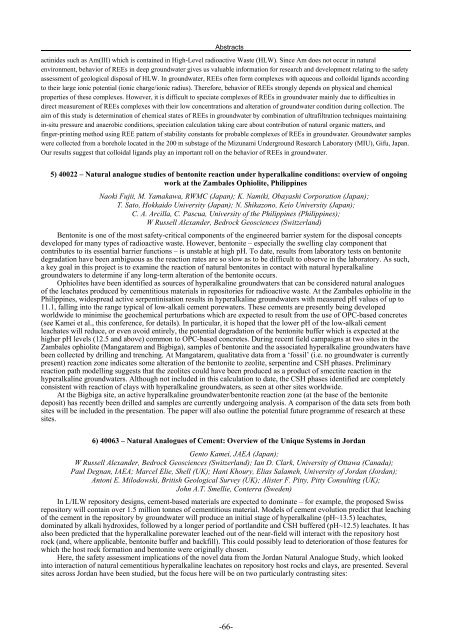ASME Message
ASME Message
ASME Message
You also want an ePaper? Increase the reach of your titles
YUMPU automatically turns print PDFs into web optimized ePapers that Google loves.
Abstracts<br />
actinides such as Am(III) which is contained in High-Level radioactive Waste (HLW). Since Am does not occur in natural<br />
environment, behavior of REEs in deep groundwater gives us valuable information for research and development relating to the safety<br />
assessment of geological disposal of HLW. In groundwater, REEs often form complexes with aqueous and colloidal ligands according<br />
to their large ionic potential (ionic charge/ionic radius). Therefore, behavior of REEs strongly depends on physical and chemical<br />
properties of these complexes. However, it is difficult to speciate complexes of REEs in groundwater mainly due to difficulties in<br />
direct measurement of REEs complexes with their low concentrations and alteration of groundwater condition during collection. The<br />
aim of this study is determination of chemical states of REEs in groundwater by combination of ultrafiltration techniques maintaining<br />
in-situ pressure and anaerobic conditions, speciation calculation taking care about contribution of natural organic matters, and<br />
finger-printing method using REE pattern of stability constants for probable complexes of REEs in groundwater. Groundwater samples<br />
were collected from a borehole located in the 200 m substage of the Mizunami Underground Research Laboratory (MIU), Gifu, Japan.<br />
Our results suggest that colloidal ligands play an important roll on the behavior of REEs in groundwater.<br />
5) 40022 – Natural analogue studies of bentonite reaction under hyperalkaline conditions: overview of ongoing<br />
work at the Zambales Ophiolite, Philippines<br />
Naoki Fujii, M. Yamakawa, RWMC (Japan); K. Namiki, Obayashi Corporation (Japan);<br />
T. Sato, Hokkaido University (Japan); N. Shikazono, Keio University (Japan);<br />
C. A. Arcilla, C. Pascua, University of the Philippines (Philippines);<br />
W Russell Alexander, Bedrock Geosciences (Switzerland)<br />
Bentonite is one of the most safety-critical components of the engineered barrier system for the disposal concepts<br />
developed for many types of radioactive waste. However, bentonite – especially the swelling clay component that<br />
contributes to its essential barrier functions – is unstable at high pH. To date, results from laboratory tests on bentonite<br />
degradation have been ambiguous as the reaction rates are so slow as to be difficult to observe in the laboratory. As such,<br />
a key goal in this project is to examine the reaction of natural bentonites in contact with natural hyperalkaline<br />
groundwaters to determine if any long-term alteration of the bentonite occurs.<br />
Ophiolites have been identified as sources of hyperalkaline groundwaters that can be considered natural analogues<br />
of the leachates produced by cementitious materials in repositories for radioactive waste. At the Zambales ophiolite in the<br />
Philippines, widespread active serpentinisation results in hyperalkaline groundwaters with measured pH values of up to<br />
11.1, falling into the range typical of low-alkali cement porewaters. These cements are presently being developed<br />
worldwide to minimise the geochemical perturbations which are expected to result from the use of OPC-based concretes<br />
(see Kamei et al., this conference, for details). In particular, it is hoped that the lower pH of the low-alkali cement<br />
leachates will reduce, or even avoid entirely, the potential degradation of the bentonite buffer which is expected at the<br />
higher pH levels (12.5 and above) common to OPC-based concretes. During recent field campaigns at two sites in the<br />
Zambales ophiolite (Mangatarem and Bigbiga), samples of bentonite and the associated hyperalkaline groundwaters have<br />
been collected by drilling and trenching. At Mangatarem, qualitative data from a ‘fossil’ (i.e. no groundwater is currently<br />
present) reaction zone indicates some alteration of the bentonite to zeolite, serpentine and CSH phases. Preliminary<br />
reaction path modelling suggests that the zeolites could have been produced as a product of smectite reaction in the<br />
hyperalkaline groundwaters. Although not included in this calculation to date, the CSH phases identified are completely<br />
consistent with reaction of clays with hyperalkaline groundwaters, as seen at other sites worldwide.<br />
At the Bigbiga site, an active hyperalkaline groundwater/bentonite reaction zone (at the base of the bentonite<br />
deposit) has recently been drilled and samples are currently undergoing analysis. A comparison of the data sets from both<br />
sites will be included in the presentation. The paper will also outline the potential future programme of research at these<br />
sites.<br />
6) 40063 – Natural Analogues of Cement: Overview of the Unique Systems in Jordan<br />
Gento Kamei, JAEA (Japan);<br />
W Russell Alexander, Bedrock Geosciences (Switzerland); Ian D. Clark, University of Ottawa (Canada);<br />
Paul Degnan, IAEA; Marcel Elie, Shell (UK); Hani Khoury, Elias Salameh, University of Jordan (Jordan);<br />
Antoni E. Milodowski, British Geological Survey (UK); Alister F. Pitty, Pitty Consulting (UK);<br />
John A.T. Smellie, Conterra (Sweden)<br />
In L/ILW repository designs, cement-based materials are expected to dominate – for example, the proposed Swiss<br />
repository will contain over 1.5 million tonnes of cementitious material. Models of cement evolution predict that leaching<br />
of the cement in the repository by groundwater will produce an initial stage of hyperalkaline (pH~13.5) leachates,<br />
dominated by alkali hydroxides, followed by a longer period of portlandite and CSH buffered (pH~12.5) leachates. It has<br />
also been predicted that the hyperalkaline porewater leached out of the near-field will interact with the repository host<br />
rock (and, where applicable, bentonite buffer and backfill). This could possibly lead to deterioration of those features for<br />
which the host rock formation and bentonite were originally chosen.<br />
Here, the safety assessment implications of the novel data from the Jordan Natural Analogue Study, which looked<br />
into interaction of natural cementitious hyperalkaline leachates on repository host rocks and clays, are presented. Several<br />
sites across Jordan have been studied, but the focus here will be on two particularly contrasting sites:<br />
-66-


